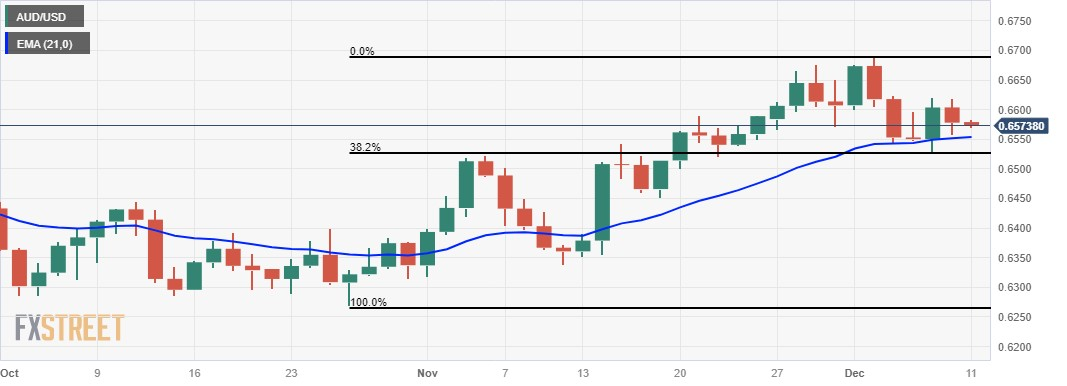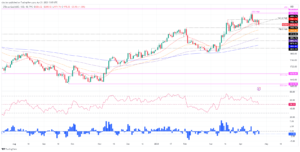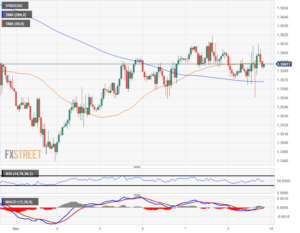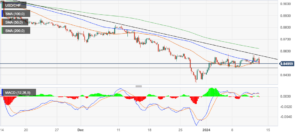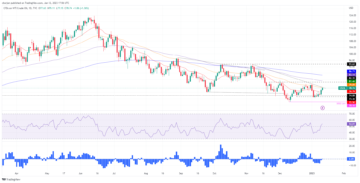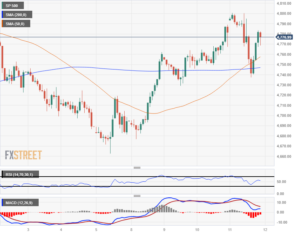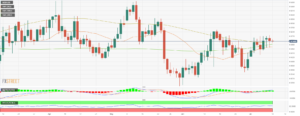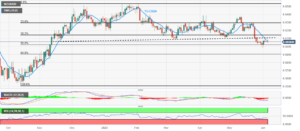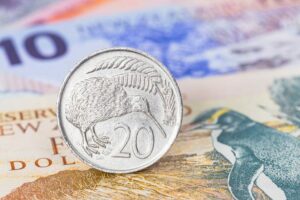- Australian Dollar continues to move downward on the firm US Dollar.
- Australia’s chief policymaker Michele Bullock will deliver a speech on Tuesday.
- China’s CPI declined by 0.5% in November on both monthly and yearly basis.
- US NFP rose by 199,000 in November against the previous rise of 150,000.
The Australian Dollar (AUD) extends its losses for the second successive session on Monday. The robust employment figures in the United States (US) bolstered the Greenback on Friday, exerting downward pressure on the AUD/USD pair. Furthermore, worries about deflation in China, coupled with a Consumer Price Index (CPI) and Producer Price Index (PPI) that fell short of expectations, contributed to a selling spree on the Australian Dollar (AUD).
Australia’s chief policymaker Michele Bullock, the Governor of the Reserve Bank of Australia (RBA), is scheduled to deliver a speech on Tuesday. The RBA opted to maintain the cash rate at 4.35% at its December meeting. While the RBA maintains a tightening bias, recent economic indicators suggest a likelihood of no further rate hikes in the near future.
US Bureau of Labor Statistics (BLS) revealed on Friday that November’s US Nonfarm Payrolls (NFP) exceeded market forecasts. Simultaneously, the Unemployment Rate saw a decline during the same period. Consequently, there has been an upward surge in US Treasury yields, supporting the strengthening of the USD.
The stronger employment data have ignited discussions and speculations about the forthcoming path of the US Federal Reserve’s (Fed) monetary policy and the duration for which the central bank intends to uphold rates at restrictive levels. The attention will be on the US Consumer Price Index (CPI) on Tuesday and the Fed Interest Rate Decision on Wednesday.
Daily Digest Market Movers: Australian Dollar moves downward on a negative bias
- Australia’s Trade Balance (MoM) data was released last week and showed a surplus of 7,129M against the expected figures of 7,500M in October.
- China’s Consumer Price Index (CPI) experienced a year-on-year decline of 0.5% in November, compared to a 0.2% decrease in October. On a monthly basis, Chinese inflation fell by 0.5%, surpassing the 0.1% decline observed in October.
- China’s Producer Price Index (PPI) recorded a 3.0% year-on-year drop in November, reflecting a more substantial decline than the 2.6% decrease reported in October.
- US Nonfarm Payrolls for November rose by 199,000 against the previous rise of 150,000 in October and the market expectation of 180,000.
- US Average Hourly Earnings (Year-on-Year) held steady at 4.0%, aligning with market projections for November. Meanwhile, the Unemployment Rate dropped to 3.7% from the previous 3.9%.
- The preliminary Michigan Consumer Sentiment Index for December reached 69.4, a notable increase from the previous reading of 61.3.
Technical Analysis: Australian Dollar looks to reach the major level at 0.6550
The Australian Dollar trades lower around 0.6560 on Monday. The 21-day Exponential Moving Average (EMA) at 0.6553 could act as a key support, which is lined up with the major level at 0.6550. A break below the support region could put weight on the AUD/USD pair to navigate the area around 38.2% Fibonacci retracement at 0.6526 level. On the upside, the psychological level at 0.6600 would likely serve as a potential barrier.
AUD/USD: Daily Chart
Australian Dollar price today
The table below shows the percentage change of Australian Dollar (AUD) against listed major currencies today. Australian Dollar was the weakest against the Euro.
| USD | EUR | GBP | CAD | AUD | JPY | NZD | CHF | |
| USD | -0.02% | 0.07% | 0.11% | 0.33% | 0.26% | 0.08% | -0.02% | |
| EUR | 0.02% | 0.11% | 0.14% | 0.35% | 0.28% | 0.11% | -0.01% | |
| GBP | -0.06% | -0.11% | 0.04% | 0.25% | 0.20% | 0.01% | -0.10% | |
| CAD | -0.11% | -0.15% | -0.07% | 0.21% | 0.15% | -0.02% | -0.14% | |
| AUD | -0.33% | -0.35% | -0.26% | -0.21% | -0.05% | -0.23% | -0.35% | |
| JPY | -0.26% | -0.29% | -0.29% | -0.16% | 0.06% | -0.19% | -0.29% | |
| NZD | -0.09% | -0.11% | -0.02% | 0.02% | 0.24% | 0.18% | -0.12% | |
| CHF | 0.03% | 0.01% | 0.09% | 0.14% | 0.35% | 0.29% | 0.12% |
The heat map shows percentage changes of major currencies against each other. The base currency is picked from the left column, while the quote currency is picked from the top row. For example, if you pick the Euro from the left column and move along the horizontal line to the Japanese Yen, the percentage change displayed in the box will represent EUR (base)/JPY (quote).
RBA FAQs
The Reserve Bank of Australia (RBA) sets interest rates and manages monetary policy for Australia. Decisions are made by a board of governors at 11 meetings a year and ad hoc emergency meetings as required. The RBA’s primary mandate is to maintain price stability, which means an inflation rate of 2-3%, but also “..to contribute to the stability of the currency, full employment, and the economic prosperity and welfare of the Australian people.” Its main tool for achieving this is by raising or lowering interest rates. Relatively high interest rates will strengthen the Australian Dollar (AUD) and vice versa. Other RBA tools include quantitative easing and tightening.
While inflation had always traditionally been thought of as a negative factor for currencies since it lowers the value of money in general, the opposite has actually been the case in modern times with the relaxation of cross-border capital controls. Moderately higher inflation now tends to lead central banks to put up their interest rates, which in turn has the effect of attracting more capital inflows from global investors seeking a lucrative place to keep their money. This increases demand for the local currency, which in the case of Australia is the Aussie Dollar.
Macroeconomic data gauges the health of an economy and can have an impact on the value of its currency. Investors prefer to invest their capital in economies that are safe and growing rather than precarious and shrinking. Greater capital inflows increase the aggregate demand and value of the domestic currency. Classic indicators, such as GDP, Manufacturing and Services PMIs, employment, and consumer sentiment surveys can influence AUD. A strong economy may encourage the Reserve Bank of Australia to put up interest rates, also supporting AUD.
Quantitative Easing (QE) is a tool used in extreme situations when lowering interest rates is not enough to restore the flow of credit in the economy. QE is the process by which the Reserve Bank of Australia (RBA) prints Australian Dollars (AUD) for the purpose of buying assets – usually government or corporate bonds – from financial institutions, thereby providing them with much-needed liquidity. QE usually results in a weaker AUD.
Quantitative tightening (QT) is the reverse of QE. It is undertaken after QE when an economic recovery is underway and inflation starts rising. Whilst in QE the Reserve Bank of Australia (RBA) purchases government and corporate bonds from financial institutions to provide them with liquidity, in QT the RBA stops buying more assets, and stops reinvesting the principal maturing on the bonds it already holds. It would be positive (or bullish) for the Australian Dollar.
- SEO Powered Content & PR Distribution. Get Amplified Today.
- PlatoData.Network Vertical Generative Ai. Empower Yourself. Access Here.
- PlatoAiStream. Web3 Intelligence. Knowledge Amplified. Access Here.
- PlatoESG. Carbon, CleanTech, Energy, Environment, Solar, Waste Management. Access Here.
- PlatoHealth. Biotech and Clinical Trials Intelligence. Access Here.
- Source: https://www.fxstreet.com/news/australian-dollar-extends-its-losses-on-a-negative-sentiment-202312110125
- :has
- :is
- :not
- $UP
- 000
- 1
- 11
- 150
- 180
- 2%
- 31
- 32
- 33
- 35%
- 41
- 7
- a
- About
- achieving
- Act
- actually
- Ad
- After
- against
- aggregate
- ahead
- aligning
- along
- already
- also
- always
- an
- analysis
- and
- Animate
- ARE
- AREA
- around
- AS
- Assets
- At
- attention
- attracting
- AUD
- AUD/USD
- aussie
- Australia
- Australian
- Australian dollar
- average
- Balance
- Bank
- Banks
- barrier
- base
- basis
- BE
- been
- below
- bias
- board
- Bonds
- both
- Box
- Break
- Bullish
- Bureau
- bureau of labor statistics
- but
- Buying
- by
- CAN
- capital
- capital controls
- case
- Cash
- central
- Central Bank
- Central Banks
- change
- Changes
- chief
- China
- chinese
- classic
- Column
- compared
- Consequently
- consumer
- consumer price index
- consumer sentiment
- content
- continues
- contribute
- contributed
- controls
- Corporate
- could
- coupled
- CPI
- credit
- cross-border
- currencies
- Currency
- daily
- data
- December
- decision
- decisions
- Decline
- decrease
- deflation
- deliver
- Demand
- Digest
- discussions
- displayed
- Dollar
- dollars
- Domestic
- downward
- Drop
- dropped
- duration
- during
- each
- Earnings
- easing
- Economic
- economic indicators
- economic recovery
- economies
- economy
- effect
- EMA
- emergency
- employment
- encourage
- ends
- enough
- EUR
- Euro
- example
- exceeded
- expanded
- expectation
- expectations
- expected
- experienced
- exponential
- exponential moving average
- extends
- extreme
- factor
- FAQ
- Fed
- Federal
- federal reserve
- Figures
- financial
- Financial institutions
- Firm
- flow
- For
- forecasts
- forthcoming
- Friday
- from
- full
- further
- Furthermore
- future
- GDP
- General
- Global
- Government
- Governor
- governors
- greater
- Greenback
- Ground
- Growing
- had
- Have
- Health
- Held
- High
- higher
- Hikes
- holds
- Horizontal
- HTTPS
- if
- Impact
- in
- include
- Increase
- Increases
- index
- Indicators
- inflation
- inflation rate
- inflows
- influence
- institutions
- intends
- interest
- INTEREST RATE
- Interest Rates
- Invest
- Investors
- IT
- ITS
- Japanese
- Japanese Yen
- Keep
- Key
- labor
- Last
- lead
- left
- Level
- levels
- likelihood
- likely
- Line
- lined
- Liquidity
- Listed
- local
- LOOKS
- lose
- losses
- lower
- lowering
- lucrative
- made
- Main
- maintain
- maintains
- major
- manages
- mandate
- manufacturing
- map
- Market
- May..
- means
- Meanwhile
- meeting
- meetings
- Michigan
- Modern
- module
- mom
- Monday
- Monetary
- Monetary Policy
- money
- monthly
- more
- move
- Movers
- moves
- moving
- moving average
- much-needed
- Navigate
- Near
- negative
- nfp
- no
- Nonfarm
- Nonfarm Payrolls
- notable
- November
- now
- observed
- october
- of
- on
- opposite
- or
- Other
- pair
- path
- Payrolls
- People
- percentage
- period
- pick
- picked
- Place
- plato
- Plato Data Intelligence
- PlatoData
- policy
- positive
- potential
- ppi
- prefer
- preliminary
- pressure
- previous
- price
- primary
- Principal
- prints
- process
- producer
- projections
- prosperity
- provide
- providing
- psychological
- purchases
- purpose
- put
- QE
- QT
- quantitative
- Quantitative Easing
- quote
- raising
- Rate
- rate hikes
- Rates
- rather
- RBA
- reach
- reached
- Reading
- recent
- recorded
- recovery
- reflecting
- region
- relatively
- relaxation
- released
- Reported
- represent
- required
- Reserve
- reserve bank
- reserve bank of australia
- Reserve Bank of Australia (RBA)
- restore
- Restrictive
- Results
- retracement
- Revealed
- reverse
- Rise
- rising
- robust
- ROSE
- ROW
- s
- safe
- same
- saw
- scheduled
- Second
- seeking
- Selling
- sentiment
- serve
- Services
- session
- Sets
- Short
- showed
- Shows
- simultaneously
- since
- situations
- speech
- spree
- Stability
- starts
- States
- statistics
- steady
- Stops
- Strengthen
- strengthening
- strong
- stronger
- substantial
- such
- suggest
- support
- Supporting
- surge
- surpassing
- surplus
- table
- tends
- than
- that
- The
- The Area
- the Fed
- The US Federal Reserve
- their
- Them
- There.
- thereby
- this
- thought
- tightening
- times
- to
- today
- tool
- tools
- top
- trade
- trades
- traditionally
- treasury
- Treasury yields
- Tuesday
- TURN
- Underway
- unemployment
- unemployment rate
- United
- United States
- Uphold
- Upside
- upward
- us
- US Dollar
- US Federal
- us federal reserve
- US nonfarm payrolls
- US nonfarm payrolls (NFP)
- US Treasury
- US treasury yields
- USD
- used
- usually
- value
- vice
- was
- weaker
- Wednesday
- week
- weight
- Welfare
- when
- which
- while
- Whilst
- will
- with
- would
- year
- yearly
- Yen
- yields
- you
- zephyrnet

